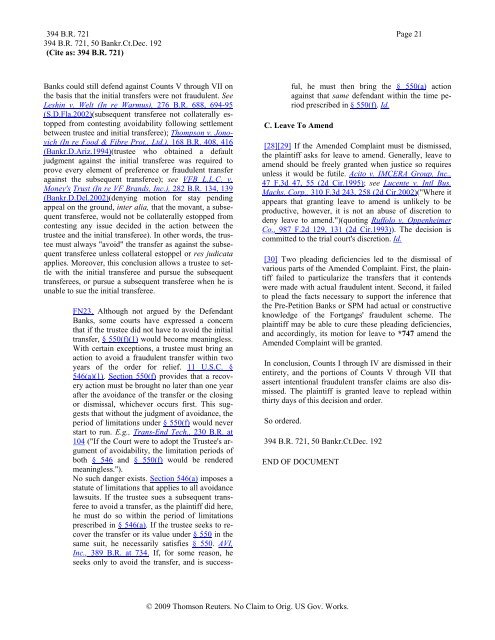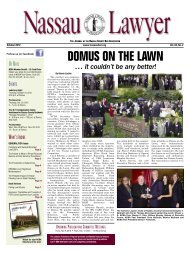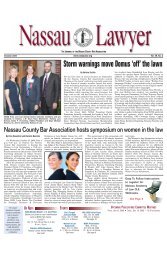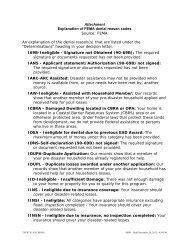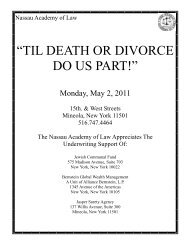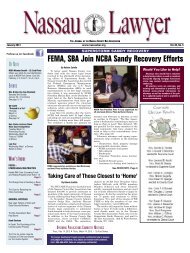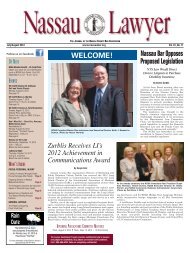394 B.R. 721 Page 20394 B.R. 721, 50 Bankr.Ct.Dec. 192(Cite as: 394 B.R. 721)F.2d 1030, 1043 (9th Cir.1983), and the impact <strong>of</strong> anyadjudication must be "direct and immediate." JanneyMontgomery Scott, 11 F.3d at 407. "[I]f the outcome <strong>of</strong>the litigation will have no practical effect on the absentee'sinterest, the absentee is not a necessary party." 4MOORE § 19.03[3][b], at 19-49. The mere possibility <strong>of</strong>collateral estoppel is not enough; "[r]ather, it must beshown that some outcome <strong>of</strong> the federal case that is reasonablylikely can preclude the absent party with respectto an issue material to the absent party's rights or dutiesunder standard principles governing the effect <strong>of</strong> priorjudgments." Janney Montgomery Scott, 11 F.3d at 409.[25][26] A transferee that retains title to or an interest inthe property conveyed is a necessary party to the fraudulenttransfer action, Valvanis v. Milgroom, 529 F.Supp.2d1190, 1199-1200 (D.Haw.2007); Nastro v. D'On<strong>of</strong>rio,263 F.Supp.2d 446, 450 (D.Conn.2003); Tanaka v. Nagata,76 Hawai'i 32, 868 P.2d 450, 454 (1994), becausethe fraudulent transfer action will affect the transferee'stitle or interest. See Tanaka, 868 P.2d at 455 ("Fundamentalprinciples <strong>of</strong> due process require that transferees whoclaim an interest in real property or its proceeds have afull and fair opportunity to contest claims <strong>of</strong> fraudulenttransfer."). Conversely, an earlier transferee who hasparted with all interest in the transferred property is notnecessary in a suit against a subsequent transferee.Tsiatsios v. Tsiatsios, 144 N.H. 438, 744 A.2d 75, 80(1999)("[W]e agree with the majority <strong>of</strong> jurisdictions thathave held that a transferor who has parted with all interestin the property can no longer *745 be affected by anydecree pertaining to the property, and that therefore thetransferor is not a necessary party to a fraudulent transferaction."); 37 AM.JUR. 2d, Fraudulent Conveyances andTransfers § 188 (Westlaw Database updated Sept.2008)("A grantee who has parted with possession <strong>of</strong> theproperty is a necessary party in some jurisdictions, but itis more frequently the case that he no longer has any interestin the subject matter and therefore is not a necessaryparty.")(footnotes omitted); 37 C.J.S., Fraudulent Conveyances§ 254 (Westlaw Database updated June2008)("As a general rule, an intermediate grantee throughwhom the title to the property passes from the debtor tothe ultimate grantee, and whose title and interest in theproperty has been divested, is not a necessary, althoughhe or she may be a proper, party ...."); see generally W.J.Dunn, Necessary Parties Defendant To Action To SetAside Conveyance In Fraud Of Creditors, 24 A.L.R.2d395, 1952 WL 7788 (1952).The Defendant Banks do not contend that Alpha Diamond,Diamfab, Fabrikant Trading India, Fabrikant HKor VSI retained an interest in the funds they transferred tothe Defendant Banks. Instead, they contend that certainFortgang Affiliates, who they do not identify, filed claimsin these cases. The Defendant Banks then state, withoutcitation to legal authority, that "[i]f the transfers in ClaimsFive through Seven are avoided, any claims against thedebtor-transferors held by Fortgang Affiliates that aretransferees <strong>of</strong> those transfers would be subject to disallowanceunder Bankruptcy Code § 502(d)." (MemorandumOf <strong>Law</strong> Of HSBC Bank USA, National Association,ABN Amro Bank N.V., Israel Discount Bank Of New York,And Sovereign Precious Metals, LLC In Further SupportOf Motion To Dismiss Complaint, dated Mar. 21, 2008, at6) (ECF Doc. # 50).The Defendant Banks failed to show that the FortgangAffiliates implicated in the last three claims filed claimsin this case. The Defendant Banks also failed to explainwhy they would be bound by a determination avoiding theinitial transfers, and could not litigate that issue in a claimobjection proceeding. Hence, there is no basis to concludethat the five Fortgang Affiliates will be prejudiced if thisaction proceeds in their absence.[27] Finally, the Fortgang Affiliates are not necessaryunder Rule 19(1)(B)(ii), which focuses on whether anexisting party--here, the four Defendant Banks--will besubjected "to a substantial risk <strong>of</strong> incurring double, multiple,or otherwise inconsistent obligations because <strong>of</strong> theinterest." The "multiple liability" clause is intended toprotect the defendant against inconsistent obligations, notinconsistent adjudications. See 4 MOORE § 19.03[4][b],[4][d] at 19-59 to -60. Thus, for example, where the plaintiffsues one <strong>of</strong> two tortfeasors, the defendant does notface "multiple liability" because it may lose in the originalaction and then lose the subsequent action for contributionagainst the other joint tortfeasor. See Janney MontgomeryScott, 11 F.3d at 411; 4 MOORE § 19.03[4][e], at 19- 63to 64. The Defendant Banks have not highlighted anyinconsistent liability that they might have to face if theylose to the plaintiff.Accordingly, the Court concludes that the Fortgang Affiliatesare not necessary or "required" parties, and it isunnecessary to consider the feasibility <strong>of</strong> their joinder, ortheir indispensability. [FN23] The plaintiff can *746 proceeddirectly against the Defendant Banks, and "avoid"the initial transfer as to them. In fact, even if the plaintiffhad successfully avoided the transfer by the debtors to theFortgang Affiliates in an earlier action, the Defendant© 2009 Thomson Reuters. No Claim to Orig. US Gov. Works.
394 B.R. 721 Page 21394 B.R. 721, 50 Bankr.Ct.Dec. 192(Cite as: 394 B.R. 721)Banks could still defend against Counts V through VII onthe basis that the initial transfers were not fraudulent. SeeLeshin v. Welt (In re Warmus), 276 B.R. 688, 694-95(S.D.Fla.2002)(subsequent transferee not collaterally estoppedfrom contesting avoidability following settlementbetween trustee and initial transferee); Thompson v. Jonovich(In re Food & Fibre Prot., Ltd.), 168 B.R. 408, 416(Bankr.D.Ariz.1994)(trustee who obtained a defaultjudgment against the initial transferee was required toprove every element <strong>of</strong> preference or fraudulent transferagainst the subsequent transferee); see VFB L.L.C. v.Money's Trust (In re VF Brands, Inc.), 282 B.R. 134, 139(Bankr.D.Del.2002)(denying motion for stay pendingappeal on the ground, inter alia, that the movant, a subsequenttransferee, would not be collaterally estopped fromcontesting any issue decided in the action between thetrustee and the initial transferee). In other words, the trusteemust always "avoid" the transfer as against the subsequenttransferee unless collateral estoppel or res judicataapplies. Moreover, this conclusion allows a trustee to settlewith the initial transferee and pursue the subsequenttransferees, or pursue a subsequent transferee when he isu nable to sue the initial transferee.FN23. Although not argued by the DefendantBanks, some courts have expressed a concernthat if the trustee did not have to avoid the initialtransfer, § 550(f)(1) would become meaningless.With certain exceptions, a trustee must bring anaction to avoid a fraudulent transfer within twoyears <strong>of</strong> the order for relief. 11 U.S.C. §546(a)(1). Section 550(f) provides that a recoveryaction must be brought no later than one yearafter the avoidance <strong>of</strong> the transfer or the closingor dismissal, whichever occurs first. This suggeststhat without the judgment <strong>of</strong> avoidance, theperiod <strong>of</strong> limitations under § 550(f) would neverstart to run. E.g., Trans-End Tech., 230 B.R. at104 ("If the Court were to adopt the Trustee's argument<strong>of</strong> avoidability, the limitation periods <strong>of</strong>both § 546 and § 550(f) would be renderedmeaningless.").No such danger exists. Section 546(a) imposes astatute <strong>of</strong> limitations that applies to all avoidancelawsuits. If the trustee sues a subsequent transfereeto avoid a transfer, as the plaintiff did here,he must do so within the period <strong>of</strong> limitationsprescribed in § 546(a). If the trustee seeks to recoverthe transfer or its value under § 550 in thesame suit, he necessarily satisfies § 550. AVI,Inc., 389 B.R. at 734. If, for some reason, heseeks only to avoid the transfer, and is successful,he must then bring the § 550(a) actionagainst that same defendant within the time pein§ 550(f) . riod prescribedId.C. Leave To Amend[28][29] If the Amended Complaint must be dismissed,the plaintiff asks for leave to amend. Generally, leave toamend should be freely granted when justice so requiresunless it would be futile. Acito v. IMCERA Group, Inc.,47 F.3d 47, 55 (2d Cir.1995); see Lucente v. Intl Bus.Machs. Corp., 310 F.3d 243, 258 (2d Cir.2002)("Where itappears that granting leave to amend is unlikely to beproductive, however, it is not an abuse <strong>of</strong> discretion todeny leave to amend.")(quoting Ruffolo v. OppenheimerC o., 987 F.2d 129, 131 (2d Cir.1993)). The decision iscommitted to the trial court's discretion. Id.[30] Two pleading deficiencies led to the dismissal <strong>of</strong>various parts <strong>of</strong> the Amended Complaint. First, the plaintifffailed to particularize the transfers that it contendswere made with actual fraudulent intent. Second, it failedto plead the facts necessary to support the inference thatthe Pre-Petition Banks or SPM had actual or constructiveknowledge <strong>of</strong> the Fortgangs' fraudulent scheme. Theplaintiff may be able to cure these pleading deficiencies,and accordingly, its motion for leave to *747 amend theAmended Complaint will be granted.In conclusion, Counts I through IV are dismissed in theirentirety, and the portions <strong>of</strong> Counts V through VII thatassert intentional fraudulent transfer claims are also dis-The plaintiff is granted leave to replead withinmissed.thirty days <strong>of</strong> this decision and order.So ordered.394 B.R. 721, 50 Bankr. Ct.Dec. 192ENDOF DOCUMENT© 2009 Thomson Reuters. No Claim to Orig. US Gov. Works.
- Page 1 and 2:
Nassau Academy of LawCLE Live Class
- Page 3 and 4:
McKinney's Debtor and Creditor Law
- Page 5 and 6:
McKinney's Debtor and Creditor Law
- Page 7 and 8:
McKinney's Debtor and Creditor Law
- Page 9 and 10:
McKinney's Debtor and Creditor Law
- Page 11 and 12:
McKinney's Debtor and Creditor Law
- Page 13 and 14:
McKinney's Debtor and Creditor Law
- Page 15 and 16:
McKinney's Debtor and Creditor Law
- Page 17 and 18:
McKinney's Debtor and Creditor Law
- Page 19 and 20:
BAKER & HOSTETLER LLP45 Rockefeller
- Page 21 and 22:
usiness of defendant Bernard L. Mad
- Page 23 and 24:
BACKGROUND, THE TRUSTEE, AND STANDI
- Page 25 and 26:
Madoff who received fraudulent tran
- Page 27 and 28:
ased on fictitious profits and for
- Page 29 and 30:
28. BLMIS funds were also used to p
- Page 31 and 32:
Madoff, and her niece, Shana Madoff
- Page 33 and 34:
42. Ruth Madoff was never an employ
- Page 35 and 36:
FIRST CAUSE OF ACTIONTURNOVER AND A
- Page 37 and 38:
66. At the time of each of the Two-
- Page 39 and 40: Transfers; (b) directing that the S
- Page 41 and 42: EIGHTH CAUSE OF ACTIONUNDISCOVERED
- Page 43 and 44: TENTH CAUSE OF ACTIONDISALLOWANCE O
- Page 45 and 46: 111. Mrs. Madoff benefited from the
- Page 47 and 48: WHEREFORE, the Trustee respectfully
- Page 49 and 50: 2(c)(3): (a) preserving the Subsequ
- Page 51 and 52: 302 B.R. 760 Page 1302 B.R. 760(Cit
- Page 53 and 54: 302 B.R. 760 Page 3302 B.R. 760(Cit
- Page 55 and 56: 302 B.R. 760 Page 5302 B.R. 760(Cit
- Page 57 and 58: 302 B.R. 760 Page 7302 B.R. 760(Cit
- Page 59 and 60: 302 B.R. 760 Page 9302 B.R. 760(Cit
- Page 61 and 62: 302 B.R. 760 Page 11302 B.R. 760(Ci
- Page 63 and 64: 302 B.R. 760 Page 13302 B.R. 760(Ci
- Page 65 and 66: 302 B.R. 760 Page 15302 B.R. 760(Ci
- Page 67 and 68: 302 B.R. 760 Page 17302 B.R. 760(Ci
- Page 69 and 70: 302 B.R. 760 Page 19302 B.R. 760(Ci
- Page 71 and 72: 394 B.R. 721 Page 1394 B.R. 721, 50
- Page 73 and 74: 394 B.R. 721 Page 3394 B.R. 721, 50
- Page 75 and 76: 394 B.R. 721 Page 5394 B.R. 721, 50
- Page 77 and 78: 394 B.R. 721 Page 7394 B.R. 721, 50
- Page 79 and 80: 394 B.R. 721 Page 9394 B.R. 721, 50
- Page 81 and 82: 394 B.R. 721 Page 11394 B.R. 721, 5
- Page 83 and 84: 394 B.R. 721 Page 13394 B.R. 721, 5
- Page 85 and 86: 394 B.R. 721 Page 15394 B.R. 721, 5
- Page 87 and 88: 394 B.R. 721 Page 17394 B.R. 721, 5
- Page 89: 394 B.R. 721 Page 19394 B.R. 721, 5
- Page 93 and 94: 397 B.R. 642 Page 2397 B.R. 642(Cit
- Page 95 and 96: 397 B.R. 642 Page 4397 B.R. 642(Cit
- Page 97 and 98: 397 B.R. 642 Page 6397 B.R. 642(Cit
- Page 99 and 100: 397 B.R. 642 Page 8397 B.R. 642(Cit
- Page 101 and 102: 397 B.R. 642 Page 10397 B.R. 642(Ci
- Page 103 and 104: 397 B.R. 642 Page 12397 B.R. 642(Ci
- Page 105 and 106: 397 B.R. 642 Page 14397 B.R. 642(Ci
- Page 107 and 108: 443 F.3d 180 Page 2443 F.3d 180(Cit
- Page 109 and 110: 443 F.3d 180 Page 4443 F.3d 180(Cit
- Page 111 and 112: 443 F.3d 180 Page 6443 F.3d 180(Cit
- Page 113 and 114: 443 F.3d 180 Page 8443 F.3d 180(Cit
- Page 115 and 116: 443 F.3d 180 Page 10443 F.3d 180(Ci
- Page 117 and 118: 443 F.3d 180 Page 12443 F.3d 180(Ci
- Page 119 and 120: Page 2257 A.D.2d 526, 684 N.Y.S.2d
- Page 121 and 122: Page 4257 A.D.2d 526, 684 N.Y.S.2d
- Page 123 and 124: Page 6257 A.D.2d 526, 684 N.Y.S.2d
- Page 125 and 126: 770 N.Y.S.2d 421 Page 22 A.D.3d 780
- Page 127 and 128: Page 14 A.D.3d 495, 773 N.Y.S.2d 71
- Page 129: Page 34 A.D.3d 495, 773 N.Y.S.2d 71
- Page 132 and 133: 780 N.Y.S.2d 409 Page 29 A.D.3d 553
- Page 134 and 135: Page 134 A.D.3d 231, 824 N.Y.S.2d 3
- Page 136 and 137: Page 334 A.D.3d 231, 824 N.Y.S.2d 3
- Page 138 and 139: Page 2991 F.2d 31(Cite as: 991 F.2d
- Page 140 and 141:
Page 4991 F.2d 31(Cite as: 991 F.2d
- Page 142 and 143:
Page 6991 F.2d 31(Cite as: 991 F.2d
- Page 144 and 145:
FRAUDULENT TRANFERENCESRonald M. Te
- Page 146 and 147:
Nursing home case_ Transfer of pers
- Page 148 and 149:
Sections 548 and 544 work in concer
- Page 150 and 151:
U.S. Supreme CourtBFP v. Resolution
- Page 152 and 153:
example, from net 15 to COD; or cha
- Page 154 and 155:
Bankruptcy Code Section§ 548. Frau
- Page 156:
Ron Terenzi is a founding partner a


